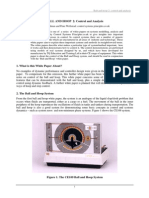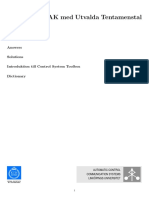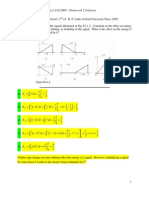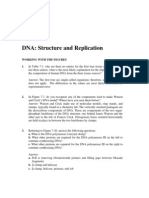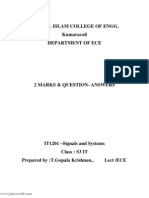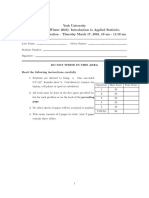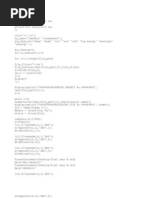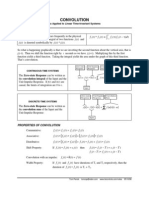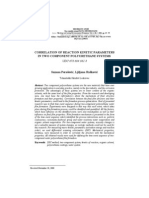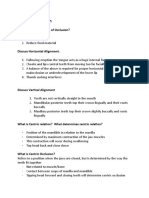Respuestas
Respuestas
Uploaded by
Andres HerediaCopyright:
Available Formats
Respuestas
Respuestas
Uploaded by
Andres HerediaCopyright
Available Formats
Share this document
Did you find this document useful?
Is this content inappropriate?
Copyright:
Available Formats
Respuestas
Respuestas
Uploaded by
Andres HerediaCopyright:
Available Formats
Chapter 1 Homework Solutions
Timothy R. Tuinstra, Ph.D.
November 2, 2010
1.1-3
a) Find the energies of the pair of signals x(t) and y(t) depicted in the gure.
b) Sketch and nd the energies of signals x(t) + y(t) and x(t) y(t). Can you
make any observation from these results?
For Fig. P1.1-3 (a)
Energy of x(t):
E
x
=
2
0
x
2
(t)dt
=
2
0
dt
= 2
Energy of y(t):
E
y
=
2
0
y
2
(t)dt
=
1
0
dt +
2
1
dt
= 2
For Fig. P1.1-3 (b)
Energy of x(t):
E
x
=
2
0
x
2
(t)dt
=
0
dt +
dt
= 2
Energy of y(t):
E
y
=
2
0
y
2
(t)dt
= 2
1
For Fig. P1.1-3 (c)
Energy of x(t):
E
x
=
0
x
2
(t)dt
=
0
dt
=
Energy of y(t):
E
y
=
0
y
2
(t)dt
=
Part b)
The energy of x(t) +y(t):
E =
2
0
(x(t) +y(t))
2
dt
=
1
0
4dt
= 4
2
The energy of x(t) y(t):
E =
2
0
(x(t) y(t))
2
dt
=
2
1
4dt
= 4
The energy of x(t) +y(t):
E =
2
0
(x(t) +y(t))
2
dt
=
2
0
4dt +
2
3
2
4dt
= 4
The energy of x(t) y(t):
E =
2
0
(x(t) y(t))
2
dt
=
3
2
2
4dt
= 4
3
The energy of x(t) +y(t):
E =
0
(x(t) +y(t))
2
dt
=
4
0
4dt
=
The energy of x(t) y(t):
E =
0
(x(t) y(t))
2
dt
=
4
4dt
= 3
4
1.1-6 Determine the power and the RMS value for each of the following
signals:
a) x(t) = 10 cos(100t +
pi
3
)
The frequency of x(t) is f =
100
2
=
50
which implies that the period is
T =
50
seconds.
P
x
=
1
T
T
x
2
(t)dt
= 100
50
50
0
cos
2
(100t +
3
)dt
= 100
50
50
0
cos
2
(100t)dt
= 100
50
50
0
(
1
2
+
1
2
cos(200t))dt
=
5000
50
1
2
= 50
The RMS value is found by computing the root of the power P
x
:
50
b) x(t) = 10 cos(100t +
3
) + 16 sin(150t +
5
)
In this case there are two sinusoids, and the power is found by computing the
power of each sinusoid and adding. Also, the phase is irrelevant when computing
power. Therefore
P
x
= 100
1
T
1
T1
cos
2
(100t)dt + 256
1
T
2
T2
sin
2
(150t)dt
= 100
1
T
1
T1
(
1
2
+
1
2
cos(200t))dt + 256
1
T
2
T2
(
1
2
1
2
sin(300t))dt
= 50 + 128
= 178
The RMS value is found by computing the root of the average power:
178
c) x(t) = (10+2 sin(3t)) cos(10t) Here, we make use of trig identities to make
our work simpler. To do that we realize that
sin() cos() =
1
2
(sin( ) + sin( +))
So now x(t) is
x(t) = 10 cos(10t) + (sin(7t) + sin(13t))
5
We have three sinusoids at 3 dierent frequencies so we add their powers.
By now it should be obvious that the power of each sinusoid is simply half the
value of the square of their amplitude:
P
x
=
10
2
2
+
1
2
+
1
2
= 51
The RMS value is
51
d) x(t) = 10 cos(5t) cos(10t)
Again, we make use of a trig identity:
x(t) = 10
1
2
(cos(5t) + cos(15t))
And the power is
P
x
=
25
2
+
25
2
= 25
The RMS value is
25 = 5
e) x(t) = 10 sin(5t) cos(10t) = 10
1
2
(sin(5t) + cos(15t))
The power is then easily calculated:
P
x
= 25
the RMS value is
25 = 5
f) x(t) = e
jt
cos(
0
t)
This happens to be a complex signals and the approach is a little dierent.
For calculating the power of complex signals we use the following formula:
P
x
=
1
T
T
|x(t)|
2
dt
where |x(t)|
2
= x(t)x (t).
So we have:
P
x
=
1
T
T
e
jt
e
jt
cos
2
(
0
t)dt
=
1
T
T
cos
2
(
0
t)dt
=
1
2
And the RMS value is
1
2
6
For the signal f(t) shown, sketch each of the following:
a) f(t 4)
b) f(
t
1.5
)
7
c) f(t)
d) f(2t 4)
8
e) f(2 t)
9
1.4-2 Express each of the signals shown by a single expression valid for all t.
a)
f
1
(t) = (4t + 4)(u(t + 1) u(t)) + (2t + 4)(u(t) u(t 2))
b)
f
2
(t) = t
2
(u(t) u(t 2)) + (2t 8)(u(t 2) u(t 4))
10
1.4-5 Evaluate the following integrals: The key to this problem is to use the
sifting property of the Dirac Delta Function.
a)
()f(t )d = f(t )|
=0
= f(t)
b)
f()(t )d = f()|
=t
= f(t)
c)
(t)e
jt
dt = e
jt
|
t=0
= 1
d)
(t 2) sin(t)dt = sin(t)|
t=2
= 0
e)
(t + 3)e
t
dt = e
t
|
t=3
= e
3
f)
(t
3
+ 4)(1 t)dt = (t
3
+ 4)|
t=1
= 5
g)
f(2 t)(3 t)dt = f(2 t)|
t=3
= f(1)
h)
e
x1
cos
2
(x 5)
(x 3)dx = e
x1
cos
2
(x 5)
|
x=3
= e
2
11
1.7-1 For the systems described by the equations below, with the input
f(t) and output y(t), determine which of the systems are linear and which are
nonlinear.
a)
y + 2y = f
2
Check to see what happens if f
1
y
1
and f
2
y
2
:
y
1
+ 2y
1
= f
2
1
y
2
+ 2y
2
= f
2
2
Now see what happens if we put in f
1
+f
2
into the system:
RHS:
(f
1
+f
2
)
2
= f
2
1
+ 2f
1
f
2
+f
2
2
= y
1
+ 2y
1
+ y
2
+ 2y
2
+ 2f
1
f
2
=
d
dt
(y
1
+y
2
) + 2(y
1
+y
2
) + 2f
1
f
2
.
This is not the same system as above and so the system is nonlinear.
b)
y + 3ty = t
2
f
Assume that f
1
y
1
and f
2
y
2
.
y
1
+ 3ty
1
= t
2
f
1
y
2
+ 3ty
2
= t
2
f
2
Now see what happens if we put in f
1
+f
2
into the system:
RHS:
t
2
(f
1
+f
2
) = t
2
f
1
+t
2
f
2
= y
1
+ 3ty
1
+ y
2
+ 3ty
2
d
dt
(y
1
+y
2
) + 3t(y
1
+y
2
)
This system matches what is given above, so this system is Linear.
c)
( y)
2
+ 2y = f
12
Assume that f
1
y
1
and f
2
y
2
.
( y
1
)
2
+ 2y
1
= f
1
( y
2
)
2
+ 2y
2
= f
2
Now see what happens if we put in f
1
+f
2
into the system:
f
1
+f
2
= ( y
1
)
2
+ 2y
1
+ ( y
2
)
2
+ 2y
2
= ( y
1
)
2
+ ( y
2
)
2
+ 2(y
1
+y
2
)
= ( y
1
+ y
2
)
2
+ 2(y
1
+y
2
)
This system is Nonlinear
d)
y +y
2
= f
Assume that f
1
y
1
and f
2
y
2
.
y
1
+y
2
1
= f
1
y
2
+y
2
2
= f
2
Now see what happens if we put in f
1
+f
2
into the system:
f
1
+f
2
= y
1
+ y
2
+y
2
1
+y
2
2
=
d
dt
(y
1
+y
2
) +y
2
1
+y
2
2
=
d
dt
(y
1
+y
2
) + (y
1
+y
2
)
2
This system is Nonlinear
e)
3y + 2 = f
Assume that f
1
y
1
and f
2
y
2
.
3y
1
+ 2 = f
1
3y
2
+ 2 = f
2
Now see what happens if we put in f
1
+f
2
into the system:
f
1
+f
2
= 3y
1
+ 3y
2
+ 2 + 2
= 3(y
1
+y
2
) + 4
= 3(y
1
+y
2
) + 2
13
This system is Nonlinear
f)
y + (sin(t))y =
f + 2f
Assume that f
1
y
1
and f
2
y
2
.
y
1
+ (sin(t))y
1
=
f
1
+ 2f
1
y
2
+ (sin(t))y
2
=
f
2
+ 2f
2
Now see what happens if we put in f
1
+f
2
into the system:
d
dt
(f
1
+f
2
) + 2(f
1
+f
2
) =
f
1
+ 2f
1
+
f
2
+ 2f
2
= y
1
+ (sin(t))y
1
+ y
2
+ (sin(t))y
2
=
d
dt
(y
1
+y
2
) + (sin(t))(y
1
+y
2
)
the system is Linear
g)
y + 2y = f
f
Assume that f
1
y
1
and f
2
y
2
.
y
1
+ 2y
1
= f
1
f
1
y
2
+ 2y
2
= f
2
f
2
Now see what happens if we put in f
1
+f
2
into the system:
(f
1
+f
2
)
d
dt
(f
1
+f
2
) = f
1
f
1
+f
2
f
2
+f
1
f
2
+f
2
f
1
= y
1
+ 2y
1
+ y
2
+ 2y
2
+f
1
f
2
+f
2
f
1
=
d
dt
(y
1
+y
2
) + 2(y
1
+y
2
) +f
1
f
2
+f
2
f
1
=
d
dt
(y
1
+y
2
) + 2(y
1
+y
2
)
this system is Nonlinear
h)
y =
f()d
14
Assume that f
1
y
1
and f
2
y
2
.
y
1
=
f
1
()d
y
2
=
f
2
()d
Now see what happens if we put in f
1
+f
2
into the system:
(f
1
+f
2
)d =
f
1
()d +
f
2
()d
= y
1
+y
2
this system is Linear
15
1.7-2 For the systems described by the equations below, with the input f(t)
and output y(t), determine which of the systems are time-invariant and which
are time-varying systems.
a)
y(t) = f(t 2)
Shift the input and see what happens:
f(t 2) = y(t )
Shifting the input just shifts the output by the same amount. this system is
Time-invariant
b)
y(t) = f(t)
f(t) y(t) = f(t)
Shifting the output:
y(t ) = f((t ))
= f( t)
Now shift the input and see if it is equivalent:
f(t ) f(t )
= f( t)
this system is Not Time-invariant
c)
y(t) = f(at)
f(t) y(t) = f(at) (1)
Shifting the output:
y(t ) = f(a(t ))
= f(at a)
Now shift the input and see if it is equivalent
f(t ) f(at )
= f(at a)
this system is Not Time-Invariant
16
d)
f(t) y(t) = tf(t 2)
Shifting the output:
y(t ) = (t )f(t 2)
Now shift the input and see if we achieve the same result:
f(t ) tf(t 2)
= (t )f(t 2)
this system is Not Time-Invariant
e)
f(t) y(t) =
5
5
f()d
Shifting the output:
y(t ) =
5
5
f()d
Now shift the input and see if we achieve the same result:
f(t )
5
5
f( )d
=
5
5
f()d
this system is Not Time-Invariant
f)
f(t) y(t) =
df
dt
2
Now shift the output:
y(t ) =
d
dt
f(t )
2
Now shift the input and see if they are equivalent:
f(t )
d
dt
f(t )
2
this system is Time-Invariant
17
1.8-3 Water ows into a tank at a rate of q
i
units/s and ows out through
the outow valve at a rate of q
0
units/s. Determine the equation relating the
outow q
0
to the input q
i
. The outow rate is proportional to the head h.
Thus q
0
= Rh where R is the valve resistance. Determine also the dierential
equation relating the head h to the input q
i
.
Hint: The net inow of water in time t is (q
i
q
0
)t. This inow is also
Ah where A is the cross section of the tank.
The key thing here is to determine what physical laws govern this system.
Clearly, the inow rate of water has to equal the rate that water is leaving the
tank plus the rate at which the tank is lling up. Lets try writing this as an
equation:
(q
i
q
0
)t = Ah
Dividing through by t and taking the limit as t 0 gives
q
i
q
0
= A
h
=
A
R
q
0
Rearranging this into the normal form of a dierential equation gives:
q
0
+
R
A
q
0
=
R
A
q
i
Finally to get D.E. relating h and q
i
, we write
q
i
Rh = A
h
and rearranging gives:
h +
R
A
h =
q
i
A
18
You might also like
- Qdoc - Tips Ece633f09hw2solutionsDocument13 pagesQdoc - Tips Ece633f09hw2solutionsTrần Trọng TiếnNo ratings yet
- Ee132b Hw1 SolDocument4 pagesEe132b Hw1 SolAhmed HassanNo ratings yet
- Ball and Hoop2Document0 pagesBall and Hoop2Parameswararao BillaNo ratings yet
- Homework SolDocument7 pagesHomework SolLoong Cheng NingNo ratings yet
- CS331-DigitalSignal Processing Two MarksDocument5 pagesCS331-DigitalSignal Processing Two MarksThilagesh JimNo ratings yet
- STAB22 FinalExam 2013F PDFDocument23 pagesSTAB22 FinalExam 2013F PDFexamkillerNo ratings yet
- RT Exercises and Solutions Med TentatalDocument264 pagesRT Exercises and Solutions Med TentatalSANA100% (1)
- Selected Solutions - An Introduction To Signal Detection and Estimation, 2nd Edition, by H. V. Poor Chapter VDocument2 pagesSelected Solutions - An Introduction To Signal Detection and Estimation, 2nd Edition, by H. V. Poor Chapter VAnderson ViníciusNo ratings yet
- ECE633 Signals and Systems I, Fall 2009 - Homework 2 SolutionsDocument13 pagesECE633 Signals and Systems I, Fall 2009 - Homework 2 SolutionsGabrielPopoola13100% (2)
- ECE633F09 HW5solutionsDocument9 pagesECE633F09 HW5solutionsJoe SmithNo ratings yet
- Normal and Poisson DistributionDocument19 pagesNormal and Poisson DistributionHarsh SharmaNo ratings yet
- hw3 2014 r0 KeyDocument10 pageshw3 2014 r0 KeyOlivia ChoiNo ratings yet
- Genetics Solution Manual - Chapter 3Document22 pagesGenetics Solution Manual - Chapter 3amarka01No ratings yet
- HH Model Documentation PDFDocument21 pagesHH Model Documentation PDFSamuel LopezNo ratings yet
- LABEX3 SolDocument57 pagesLABEX3 SolKea Hottendorf0% (1)
- DSP 2 Marks Q&a1Document38 pagesDSP 2 Marks Q&a1shankarNo ratings yet
- Exponential DistributionDocument19 pagesExponential DistributionArabi Ali ANo ratings yet
- Unit 3 Fourier Series - Signals & Systems Questions and Answers - Sanfoundry PDFDocument4 pagesUnit 3 Fourier Series - Signals & Systems Questions and Answers - Sanfoundry PDFzohaibNo ratings yet
- ExamplesDocument32 pagesExamplesvenki249No ratings yet
- Presentation Bio502 Hodgkin Huxley Neuron 3 13 17 2Document14 pagesPresentation Bio502 Hodgkin Huxley Neuron 3 13 17 2api-369102829No ratings yet
- Active Low Pass FilterDocument14 pagesActive Low Pass Filtermanthan panjikarNo ratings yet
- IGA 10e SM Chapter 06Document71 pagesIGA 10e SM Chapter 06duabgelor100% (6)
- BG31005 Tutorial PartI SolutionDocument27 pagesBG31005 Tutorial PartI Solutionasvini001No ratings yet
- IGA 10e SM Chapter 08Document12 pagesIGA 10e SM Chapter 08Muneeb ArshadNo ratings yet
- Matlab Project Section B1Document50 pagesMatlab Project Section B1Biruk TadesseNo ratings yet
- Signal Analysis: 1.1 Analogy of Signals With VectorsDocument29 pagesSignal Analysis: 1.1 Analogy of Signals With VectorsRamachandra ReddyNo ratings yet
- Linear Algebra Chapter 3 - DeTERMINANTSDocument24 pagesLinear Algebra Chapter 3 - DeTERMINANTSdaniel_bashir808No ratings yet
- Hodgkin Huxley Neuron ModelDocument9 pagesHodgkin Huxley Neuron ModelSomnath SandeepNo ratings yet
- Practice Questions Pure Maths STD 8 12Document2 pagesPractice Questions Pure Maths STD 8 12Madhusudan G. TandaleNo ratings yet
- IGA 10e SM Chapter 07Document10 pagesIGA 10e SM Chapter 07duabgelorNo ratings yet
- Final Review SolDocument24 pagesFinal Review SolRandy AfrizalNo ratings yet
- State Errors - Steady: Eman Ahmad KhalafDocument28 pagesState Errors - Steady: Eman Ahmad KhalafAhmed Mohammed khalfNo ratings yet
- Lecture Notes (Lec 1 3)Document7 pagesLecture Notes (Lec 1 3)Nirmal PanchalNo ratings yet
- Math 104 - Homework 10 Solutions: Lectures 2 and 4, Fall 2011Document4 pagesMath 104 - Homework 10 Solutions: Lectures 2 and 4, Fall 2011dsmile1No ratings yet
- HW 7 SolutionsDocument9 pagesHW 7 SolutionsDamien SolerNo ratings yet
- Signals and Systems Lecture NotesDocument183 pagesSignals and Systems Lecture NotesDrew SwindleNo ratings yet
- Ss Important QuestionsDocument21 pagesSs Important QuestionsVeera ChaitanyaNo ratings yet
- 01 Distribution FunctionsDocument7 pages01 Distribution FunctionsJhames Niño TrinidadNo ratings yet
- Phase Plane Analysis PDFDocument27 pagesPhase Plane Analysis PDFjooooooNo ratings yet
- Module-5 Part-1 - MergedDocument54 pagesModule-5 Part-1 - Mergedsiddhanth.youNo ratings yet
- 08s Cpe633 Hw1 SolutionDocument3 pages08s Cpe633 Hw1 Solutionram_786No ratings yet
- Ee132b Hw4 SolDocument11 pagesEe132b Hw4 SolDylan LerNo ratings yet
- Lecture 13 - Central Nervous SystemDocument102 pagesLecture 13 - Central Nervous Systemhamako02No ratings yet
- Xppaut NotesDocument8 pagesXppaut Notescalvk79No ratings yet
- BMS Lab Final PDFDocument28 pagesBMS Lab Final PDFKalyani ShindeNo ratings yet
- Interpreting and Calculating P-Values - MinitabDocument4 pagesInterpreting and Calculating P-Values - MinitabDhaka SylhetNo ratings yet
- Chapter 2 System IInd Order ResponsesDocument38 pagesChapter 2 System IInd Order ResponsesAli AhmadNo ratings yet
- Notes LT1Document21 pagesNotes LT1deathesNo ratings yet
- 2565 Midterm2 2016 SolutionDocument6 pages2565 Midterm2 2016 SolutionAnonymous BZkzY7d9kNo ratings yet
- Feb 24 - Linear Transformation QuestionsDocument3 pagesFeb 24 - Linear Transformation QuestionsparshotamNo ratings yet
- Matlab Code EcgDocument4 pagesMatlab Code Ecgmanik9000No ratings yet
- B39AX Topic1-P PDFDocument28 pagesB39AX Topic1-P PDFBokai ZhouNo ratings yet
- Calculus, p.450, Prob.22Document4 pagesCalculus, p.450, Prob.22theandaaymanNo ratings yet
- Exponential DistributionDocument16 pagesExponential DistributionMadhavaKrishnaNo ratings yet
- HW3 SolnDocument12 pagesHW3 SolnDanny MejíaNo ratings yet
- Stochastic Calculus For Finance II - Some Solutions To Chapter VIDocument12 pagesStochastic Calculus For Finance II - Some Solutions To Chapter VIAditya Mittal100% (1)
- Convolution TableDocument2 pagesConvolution TablebbutschNo ratings yet
- Uraian FourierDocument91 pagesUraian FourierAgus Dian PratamaNo ratings yet
- Table of Fourier Transform PairsDocument8 pagesTable of Fourier Transform PairsmayankfirstNo ratings yet
- Catalytic Chemistry in Industry: PremiseDocument36 pagesCatalytic Chemistry in Industry: Premisejai d gr8No ratings yet
- Jenn-Air Double Oven Freestanding RangeDocument20 pagesJenn-Air Double Oven Freestanding Rangejorgeluis0515No ratings yet
- Chiller BOQDocument1 pageChiller BOQbmanojNo ratings yet
- MY Structural Strengthening OVERVIEW 1511Document52 pagesMY Structural Strengthening OVERVIEW 1511Tan Peng LeakNo ratings yet
- Before 1930 1. Law of Readiness - Proposed in His Book Entitled The Original Nature of ManDocument7 pagesBefore 1930 1. Law of Readiness - Proposed in His Book Entitled The Original Nature of ManJessNo ratings yet
- Practical-Guidelines-Electrotherapy Application DefDocument10 pagesPractical-Guidelines-Electrotherapy Application DefZahid HussainNo ratings yet
- Correlation of Reaction Kinetic Parameters in Two Component Polyurethane SystemsDocument11 pagesCorrelation of Reaction Kinetic Parameters in Two Component Polyurethane SystemsWilliam SanbornNo ratings yet
- Life Prediction of Ammonia Storage Tanks Based On Laboratory Stress Corrosion Crack DataDocument15 pagesLife Prediction of Ammonia Storage Tanks Based On Laboratory Stress Corrosion Crack DataValerZLNo ratings yet
- Growth Strategy Ansoff MatrixDocument4 pagesGrowth Strategy Ansoff MatrixAndrea Demos StylesNo ratings yet
- CHM 580 Exp 1 & 7Document19 pagesCHM 580 Exp 1 & 7Nabilah60% (5)
- Spelling Bee - SynthDocument149 pagesSpelling Bee - Synthplanetinhas9No ratings yet
- Students WaiverDocument2 pagesStudents Waiverjerickolian.delrosarioNo ratings yet
- 1991-01-02-John Hart DamDocument20 pages1991-01-02-John Hart DamhjitnoNo ratings yet
- Green Bites 4Document31 pagesGreen Bites 4dielsebastian04No ratings yet
- Occlusion WorksheetDocument6 pagesOcclusion WorksheetMya MacmillanNo ratings yet
- Aaru - SCADA Operator Console PDFDocument3 pagesAaru - SCADA Operator Console PDFArumugam RajendranNo ratings yet
- What Is Abac, Rbac, EtcDocument12 pagesWhat Is Abac, Rbac, EtcvinimollNo ratings yet
- MathDocument1 pageMathapi-644644773No ratings yet
- Revision Question Mid Semester Exam (Lecturer Copy)Document14 pagesRevision Question Mid Semester Exam (Lecturer Copy)ntyn1904No ratings yet
- Training Manual On Emergency Contraceptive Pills (Ecps)Document76 pagesTraining Manual On Emergency Contraceptive Pills (Ecps)'Doyinsolami OsobukolaNo ratings yet
- Crystalpunk Playtest 1 - The EvolutionistDocument12 pagesCrystalpunk Playtest 1 - The EvolutionistRayar32No ratings yet
- Candy!: It's Dandy:)Document16 pagesCandy!: It's Dandy:)nabila OktavianiNo ratings yet
- What Is Report Text MeansDocument2 pagesWhat Is Report Text MeansimaabslmhNo ratings yet
- WC Manifold: Jeevan Bhar Ka Saath..Document2 pagesWC Manifold: Jeevan Bhar Ka Saath..arjun 11No ratings yet
- Group 4 ResearchDocument2 pagesGroup 4 Researchqueen estevesNo ratings yet
- Projectile MotionDocument58 pagesProjectile Motionrain diapoletNo ratings yet
- An Incumbent's Guide To Digital Disruption - McKinsey & CompanyDocument12 pagesAn Incumbent's Guide To Digital Disruption - McKinsey & CompanyRoberto Carlos SandovalNo ratings yet
- Definition of SculptureDocument6 pagesDefinition of SculptureErwin Roquid IsagaNo ratings yet
- Semantico Syntactic Observations: The Arabic Mood SystemDocument11 pagesSemantico Syntactic Observations: The Arabic Mood SystemArabic Tree learningNo ratings yet
- Mobile Bar Services Will Start On Jan. 01, 2015Document3 pagesMobile Bar Services Will Start On Jan. 01, 2015franz_karununganNo ratings yet


